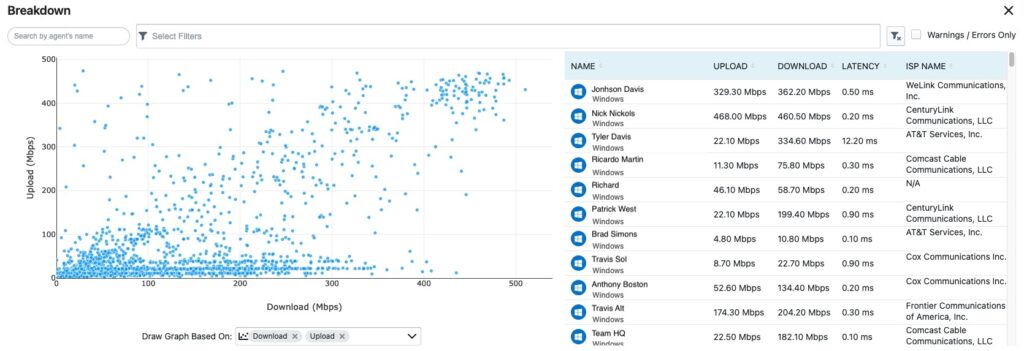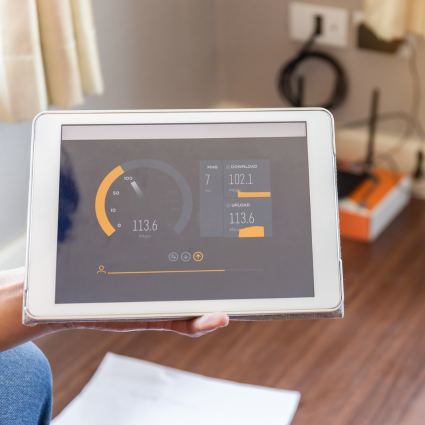ISP Network Monitoring
Internet Service Providers (ISPs) offer a key resource to our everyday’s life. We all rely on an internet connection for work, entertainment, and staying connected with the world, friends, and family. Internet services are no second to electricity and water, they are nevertheless an essential need. As a result, ISP monitoring is an essential element of an internet service provider’s operations.
Importance of Network Performance for ISPs
When providing internet connectivity, a key challenge is ensuring a good customer experience. In markets where there’s competition, switching internet service providers is relatively easy. For this reason, internet service providers focus on price and customer experience to stay competitive. Network monitoring tools are a key function of an internet service provider’s business success. It allows an ISP to enforce Service Level Agreements (SLAs) and ensure a good user experience to its paying customers.
Factors Affecting Network Performance
There are several factors that affect ISP performance for end users. This section lists the most common causes of internet outages, and available solutions that should be part of every internet service provider’s network management.
Natural disasaters
Natural events such as storms, floods, tornados, etc. can seriously disrupt the network infrastructure and should not be underestimated. From local extreme weather events that can isolate entire communities to larger ones that can put at risk the global infrastructure. The best way to deal with outages caused by natural events is to design a redundant network, where possible. Moreover, most Network Operation Centers (NOCs) constantly monitor the weather forecast to be informed about the risk of natural events.
Hardware failures
Networking hardware vendors generally provide an expected lifespan for its products. This information helps ISPs estimate the risk of hardware failures associated with a specific device. Even if a network device hasn’t reached its lifespan, it could still experience a failure. Factors that contribute to a shorter lifespan and higher failure rates are environmental factors such as temperature, humidity, and dust.
Network traffic congestion
Network traffic congestion happens when the network infrastructure is receiving more traffic than it can actually forward. Service providers that don’t provision enough network resources to match the expected Service Level Agreements will experience network traffic congestion. To address this, ISPs need to provision enough resources to sustain its subscribers’ internet activity, while constantly monitoring bandwidth consumption. This is accomplished with flow-based protocols such as NetFlow and IPFIX.
“NetBeez showed us that although our monitoring was not indicating a saturation issue or necessarily even an outage – there was an absolute performance degradation that a specific subset of customers were experiencing. We could see where the ping response time settles down during off peak hours – indicating that the issue was likely caused by network congestion.”
– Sr. Network Engineer at anonymous ISP
Download the “Delivering Exceptional Customer Experiences in the ISP Industry” white paper by NetBeez.
Suboptimal configurations
Suboptimal network configurations can reduce ISP performance. For instance, lack of Quality of Service (QoS) configuration or other similar issues will greatly impact the user experience. Only knowledgeable and experienced network architects and engineers can really address this.
Configuration errors
Mistakes made by network operators during configuration changes could lead to serious outage. The news is full of examples of human-driven outages. To reduce the risk of configuration changes errors, there are several strategies and best practices available. These include control change management procedures, use of network simulation software, and continuous network testing.
Network security
Security events such as Distributed Denial of Service (DDoS), ransomware, and brute-force attacks can bring a service provider to its knees. Security tools such as SIEM (Security Information and Event Management), IDP (Intrusion Detection and Prevention), and others are necessary to reduce the risk of security threats for an ISP.
Optimizing Network Performance
To optimize network performance, internet service providers use network monitoring software that track bandwidth usage and analyze internet traffic. Bandwidth usage data helps understanding if the network infrastructure meets the SLAs of its subscribers’ internet traffic. Traffic analysis enriches this data by breaking down the internet activity across applications, protocols, and destinations. This information helps network architects and operators to optimize network design and network configuration.
Proactive Issue Identification and Resolution
Proactive issue identification and resolution is necessary for optimal network availability and uptime. Network outages due to weather conditions, device failures, and other external events are not always avoidable. However, the sooner they are detected, the sooner they can be addressed. Continuous network testing enables proactive issue identification and network performance monitoring.
ISP Monitoring: Key Performance Metrics
There are relatively few metrics that really matter when monitoring ISP performance. While most users believe that internet speed is all you need, there are two other key metrics that are equally important: latency, and packet loss. Latency measures the time that it takes for a data packet to travel from its source to its destination. Packet loss measures the ratio of dropped packets to total packets sent. These two metrics have a direct impact on end-user experience, especially with TCP connections. Ignore them at your own cost. Let’s now deep dive into key aspects of ISP network monitoring.
Key Aspects of Network Performance Monitoring
Ensuring the seamless operation of an ISP’s network infrastructure requires a comprehensive approach to monitoring and managing performance. Here are the key aspects that ISPs should focus on:
Real-time Monitoring Tools and Techniques
To effectively monitor network performance, ISPs need access to real-time monitoring tools. Active network monitoring tools like NetBeez provide visibility into various aspects of the network. These tools provide path analysis, bandwidth availability, latency, and packet loss data. By continuously testing and monitoring these metrics, ISPs can identify performance issues as they arise and take immediate action to resolve them. This enables them to minimize network downtime and ensures a smooth user experience for subscribers.
Traffic Analysis and Bandwidth Management
Traffic analysis plays a crucial role in internet service provider monitoring. ISPs need to analyze network traffic patterns to identify trends, anomalies, and potential bottlenecks. By understanding how traffic flows through the network, ISPs can optimize bandwidth allocation, prioritize critical applications via bandwidth throttling, and optimize application performance. Effective bandwidth management helps prevent congestion and latency issues, ensuring consistent performance for all customers.
Identifying and Resolving Bottlenecks
Bottlenecks are points in the network where network traffic is congested. This leads to degraded network performance for network subscribers. Identification of bottlenecks is essential for quick resolution in order to maintain optimal network performance. ISPs can use path analysis to locate where bottlenecks originate. This will help to quickly identify if the root cause is related to a hardware failure, oversubscribed router, or software misconfiguration. By addressing these issues promptly, ISPs can alleviate congestion and improve overall network performance.
Best Practices for Effective ISP Performance Monitoring
NetBeez is a network performance monitoring solution that provides an easy way to bridge the gap between network performance and customer experience. By deploying hardware, virtual, and software network monitoring agents, NetBeez constantly verifies end-to-end network and application performance. Implementing ISP network monitoring with NetBeez is simple …
Deploy Network Monitoring Agents
NetBeez offers hardware, virtual, and software appliances that run network performance monitoring tests. The agents are plug-and-play that can be easily installed at customers’ locations or network aggregation points within the ISP network infrastructure.

Configure Network Monitoring Tests
NetBeez agents support a variety of network tests that provide key performance metrics, such as download, upload speed, packet loss, and latency. These network performance tests include commands such as ping, iperf, network speed and more. Tests are real-time for quick detection of performance degradation issues. Historical data is retained on the central server so these baselines are used to generate alerts and notification when bottlenecks and outages occur.

Implementing Automated Alerts and Notifications
NetBeez anomaly detection system is based on the continuous testing that agents run. Each network performance test generates a baseline that is used in alert profiles. Notifications are easily delivered via standard protocols, such as SMTP, SNMP, and syslog, or third party integrations. NetBeez supports out-of-the-box integrations with ticketing systems such ServiceNow and PagerDuty, chat services such as MS Teams and Slack, and more. NOC teams can get alerted when an outage or performance degradation occurs.
Conclusion
To ensure the seamless operation of an ISP’s network infrastructure, comprehensive monitoring and management of performance are essential. Real-time monitoring tools like NetBeez offer visibility into crucial metrics such as bandwidth availability, latency, and packet loss. By analyzing traffic patterns and optimizing bandwidth allocation, ISPs can prevent congestion and prioritize critical applications, thus enhancing overall network performance. Prompt identification and resolution of bottlenecks are crucial, achieved through path analysis and quick troubleshooting. Implementing best practices such as deploying network monitoring agents and configuring tests enable ISPs to maintain high performance levels. With automated alerts and notifications, issues are swiftly addressed, minimizing downtime and ensuring a smooth user experience for subscribers. Download the white paper “Delivering Exceptional Customer Experiences in the ISP Industry with NetBeez“. Discover how to use NetBeez for ISP network monitoring.





